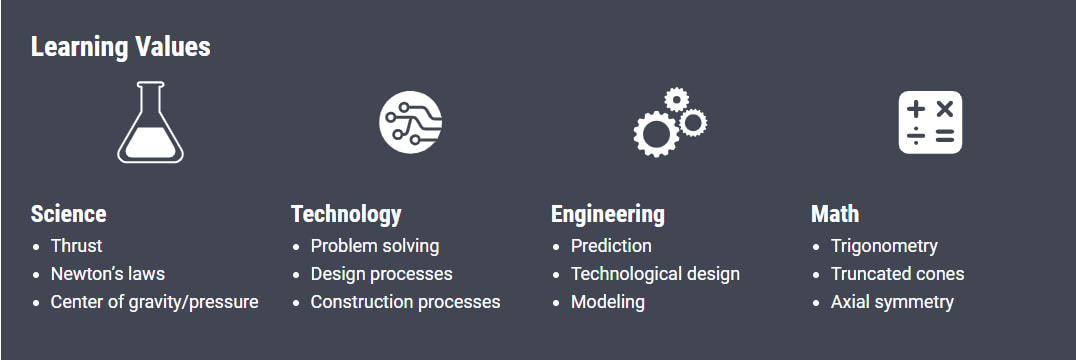Water Rockets - Research Page
Rocket Software:
www.seeds2lrn.com/rocketSoftware.html
www.seeds2lrn.com/rocketSoftware.html
Rocket Research 101
Start by going through the guide here on Nasa's website!
https://www.grc.nasa.gov/www/k-12/rocket/BottleRocket/journey101test.htm
As you come across questions type them up and save them into a document labeled "YOUR NAME - ROCKET RESEARCH 101"
Write down keywords with a short definition so you are able to take part in discussions about the topics we cover:
Keywords (there may be more):
-Thrust
-Propulsion
-The Law of Proportionality
Questions to consider (there may be more):
Make sure to check out the bottle rocket simulator and write down any data you discover!
Start by going through the guide here on Nasa's website!
https://www.grc.nasa.gov/www/k-12/rocket/BottleRocket/journey101test.htm
As you come across questions type them up and save them into a document labeled "YOUR NAME - ROCKET RESEARCH 101"
Write down keywords with a short definition so you are able to take part in discussions about the topics we cover:
Keywords (there may be more):
-Thrust
-Propulsion
-The Law of Proportionality
Questions to consider (there may be more):
- How much thrust is required to keep you in a constant level but not launch you into space?
Make sure to check out the bottle rocket simulator and write down any data you discover!
Rocket Research 102
https://www.grc.nasa.gov/www/K-12/rocket/BottleRocket/journey102.htm
Key Ideas:
Rocket Stability
Keywords (there may be more):
Aerodynamics
Questions to consider:
https://www.grc.nasa.gov/www/K-12/rocket/BottleRocket/journey102.htm
Key Ideas:
Rocket Stability
Keywords (there may be more):
Aerodynamics
Questions to consider:
- What is a regular water bottle missing compared to a proper rocket?
- What happens when you add a nose cone to a bottle filled with water?
- How does adding fins help your bottle rocket?
- What is the best fin configuration?
- Why does a weathervane point into the wind?
- Weathervanes point in the direction of the wind. How do they accomplish this?
Rocket Research 102
https://www.grc.nasa.gov/www/k-12/rocket/BottleRocket/journey103.htm
Keywords (there may be more):
Drag
Questions to Consider
https://www.grc.nasa.gov/www/k-12/rocket/BottleRocket/journey103.htm
Keywords (there may be more):
Drag
Questions to Consider
- Write down two advantages of having a rocket with low air drag
- Which shape nose cone caused the rocket to reach the highest altitude? (use simulator)
- Do you think a SHARP or Pointed nose cone would be even better?
- The fairing is a skirt surrounding the nozzle. Is it useful?
Next Steps!
Now that you have finished the 3 theory units answer the following questions!
- Do I have to use water? Why can't I just use pressurized air?
- Is more water better?
- How can I modify the design of the rocket to increase the duration of the flight?
- What effect will the wind have on the way I launch the rocket?
- How will the wind affect the rocket after it is launched?
- How can I modify the design of the rocket to increase its chances of making a field goal or reaching a goal?
ACTIVITY TIME!
Let's build some rockets!
Materials:
You will need to bring in at least two 2L bottles to create two different water bottle rockets. Testing out 2 different designs will help you determine which is more efficient at reaching a higher altitude safely.
Nose cones, fins, etc can be made out of regular classroom materials (cardboard, paper, etc) as well as other things you think may help your rocket be successful!
Objective:
During the completion of this activity, you will demonstrate science processing skills, an ability to use technological design, and an ability to identify factors that affect motion and forces.
Background Information:
Bottle rockets are excellent devices for investigating "Newton's Three Laws of Motion":
1st Law - A rocket will remain on the launch pad until an unbalanced force is exerted, propelling the rocket upward.
2nd Law - The amount of force depends upon how much air is pumped inside the rocket. You can increase the force further by adding a small amount of water, which increases the mass expelled by the air pressure in the rocket .
3rd Law - Finally, the action force of the air (and water) as it rushes out of the nozzle creates an equal and opposite reaction force propelling the rocket upward.
As with a balloon, air pressurizes the bottle rocket. Adding a small amount of water to the bottle increases the action force. The water expels from the bottle before the air does, turning the bottle rocket into a bigger version of a water rocket toy (available in toy stores).
Let's build some rockets!
Materials:
You will need to bring in at least two 2L bottles to create two different water bottle rockets. Testing out 2 different designs will help you determine which is more efficient at reaching a higher altitude safely.
Nose cones, fins, etc can be made out of regular classroom materials (cardboard, paper, etc) as well as other things you think may help your rocket be successful!
Objective:
During the completion of this activity, you will demonstrate science processing skills, an ability to use technological design, and an ability to identify factors that affect motion and forces.
Background Information:
Bottle rockets are excellent devices for investigating "Newton's Three Laws of Motion":
1st Law - A rocket will remain on the launch pad until an unbalanced force is exerted, propelling the rocket upward.
2nd Law - The amount of force depends upon how much air is pumped inside the rocket. You can increase the force further by adding a small amount of water, which increases the mass expelled by the air pressure in the rocket .
3rd Law - Finally, the action force of the air (and water) as it rushes out of the nozzle creates an equal and opposite reaction force propelling the rocket upward.
As with a balloon, air pressurizes the bottle rocket. Adding a small amount of water to the bottle increases the action force. The water expels from the bottle before the air does, turning the bottle rocket into a bigger version of a water rocket toy (available in toy stores).

